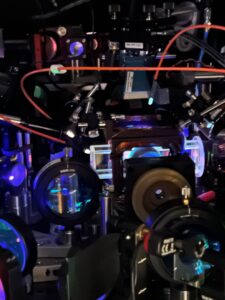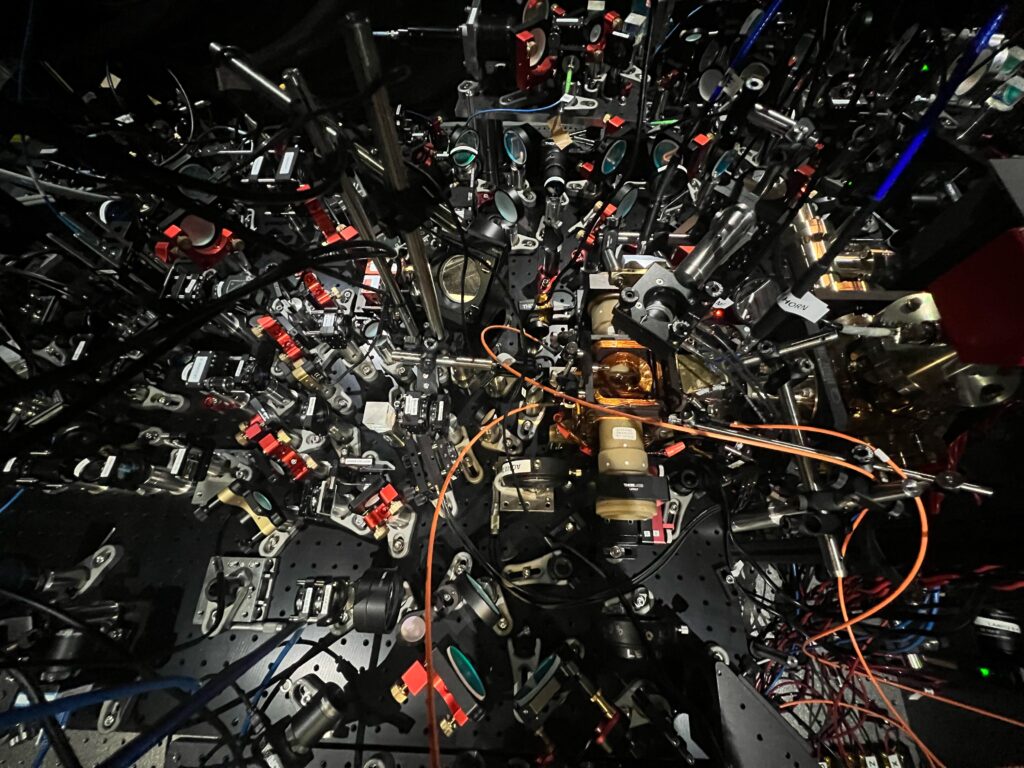Networks / Cyber
WASHINGTON — Widespread quantum computing may now come years sooner than widely expected, thanks to a Pentagon-funded project with implications for everything from rapid vaccine development and weather forecasting to cyber warfare and codebreaking.
If the Harvard-led experiment can be replicated and scaled up, it would still take years to make quantum computers widely available to run new forms of artificial intelligence for medical research, scientific experimentation and military command-and-control. But early adopters would almost certainly include intelligence agencies eager to crack encryption protocols widely used by governments and businesses alike. That makes it all the more urgent to implement the new quantum-resistant encryption algorithms the National Institute of Standards & Technology aims to finalize in 2024.
On Wednesday afternoon, the Defense Advanced Research Projects Agency (DARPA) and a paper in Nature announced results from a team of almost two dozen scientists, most of them from Harvard, funded by a DARPA program known as ONISQ (Optimization with Noisy Intermediate-Scale Quantum devices). By manipulating individual atoms with precise, low-powered laser beams, known in the trade as “laser tweezers,” the team was able to create “quantum circuits” that correct for errors much more efficiently than alternative techniques — potentially overcoming the biggest barrier to practical quantum computers.
“Quantum error correction is fundamentally challenging,” said Mukund Vengalattore, DARPA’s program manager for ONISQ.
“You cannot copy quantum information and you can also not measure the quantum state without destroying it,” said Mikhail Lukin, one of the Harvard scientists, in an interview with Breaking Defense.
Different corporate, government and academic teams have tried various approaches to error correction, but they all waste an “exorbitant” amount of the quantum computer’s power, Vengalattore explained. But now the Harvard team has found a radically more efficient way to guard against errors.
“This is truly revolutionary,” Vengalattore told Breaking Defense in an interview. “Having been demonstrated and even validated in this paper … we are off to the races.”
How fast are scientists racing? A back-of-the-envelope calculation suggests that the Harvard-team’s experimental quantum computer is potentially four times as powerful as the most advanced quantum chip available for purchase, IBM’s Condor.
Unveiled Dec. 4, Condor boasts over a thousand quantum bits, or qubits — 1,121, to be precise — which is almost three-fold increase over last year’s record-breaking IBM Osprey. But what’s a qubit? The term turns out to have multiple meanings.
While a normal “classical” computer uses bits that can represent either 0 or 1, a qubit exploits the fuzzy nature of quantum phenomena to let it represent all the infinite possible values in between. That’s a nifty trick that could shortcut previously impossible calculations. But because quantum phenomena are so strange, it’s also much harder to figure out whether a qubit is working properly or glitching out.
So quantum computers to date have to devote most of their qubits to double-checking each other. That means the number of usable “logical qubits” that can actually do reliable calculations is orders of magnitude smaller than the number of actual “physical qubits” in the machine. (Yes, the terminology can be nearly as fuzzy as quantum theory.)
Using current error-correcting methods, it takes more than a thousand physical qubits acting together to form one logical qubit. IBM is now exploring a new, more efficient error-correcting technique it says should allow a mere hundred physical qubits to form a logical qubit. So depending on which technique is used, a high-end chip with a thousand physical qubits, like Condor, could generate as little as one usable logical qubit or as many as ten.
The Harvard team, however, used a radical new approach to error correction that turns a mere 280 physical qubits into 48 logical qubits. That’s about 20 times better than what IBM is hoping to achieve in its next-generation chip and 200 times more efficient than the 1,000-to-one ratio that current techniques try to reach.
“Up till now the state-of-the-art was people have realized one logical qubit or maybe two … we have done it to 48,” Lukin said. “For the first time, we’ve built actually a processor which operates on these logical qubits. … We demonstrated the key basic elements of this processor, namely the ability to encode, decode, do gate operations. … For the first time, we executed algorithms with logical qubits.”
Vengalattore said it “really is transformative.”
“All the previous estimates: … How many physical qubits do we need to do something useful? How many physical qubits do we need to do error correction?… All of that is now in a sense up in the air, because we need to rethink all of those algorithms and all of those estimates,” he said.
Skip Sanzieri, co-founder of QuSecure, which builds software to defend against quantum-powered hacking, said logical qubits are the “Holy Grail” for quantum computing.
“[Physical] qubits are very ethereal: they can be disturbed easily,” he said, which is what leads to errors.

Close-up of the glass “cell” in the Harvard quantum computing experiment, where atoms are trapped and manipulated by “laser tweezers” to form quantum circuits. (Harvard photo)
With the Harvard team’s approach, “you don’t need the thousands, hundreds of thousands, [or] millions of [physical] qubits to error-correct,” Sanzieri told Breaking Defense. “It’s a huge speed-up, amazing — if this works.”
Even the low-hanging fruit is potentially life-saving. If scientists can scale up the Harvard team’s 48 logical qubits six-fold, to 286, “we could simulate molecules with the complexity of penicillin — [which] could take as many classical bits as atoms in the universe,” added another QuSecure co-founder, Rebecca Krauthammer. “Things like simulating protein folding and trading strategy optimization become tractable.”
“When we close in on a thousand logical qubits and beyond … this could translate to instantaneous diagnostics, crafting treatments from exhaustive medical histories in mere moments,” Krauthammer continued.
On the cybersecurity front, she said, at 4,000 logical qubits, “the data that has been harvested over the last several years can be decrypted” — potentially exposing all sorts of previously secure information, from Social Security numbers to state secrets.
In this context, the Harvard team’s 48 logical qubits may not sound like a lot. But the power of a quantum computer increases exponentially. The best measure of raw potential computing power is the number of possible configurations of qubits. For 10 qubits, that’s just over one thousand (1,024). For 48 qubits, that figure rises to over 280 trillion.
(To be precise, it’s 281,474,976,710,656. That’s about seven times more than the number of cells in the human body but still a lot less than the number of sand grains on Earth).
But it doesn’t top out there. Vengalattore is confident that the Harvard approach scales up more easily than other quantum computer designs, putting much larger numbers of logical qubits in reach. That’s because the Harvard team uses a form of physical qubit that — by the standards of imperceptibly tiny particles — is relatively easy to work with. Instead of using superconductors or electrically charged ions, it employs electrically neutral atoms, cooled to ultra-low temperatures.
“The established platforms like superconductng qubits and so on, they have been working towards [error correction] for a long time, but it turns out it is very hard for them to actually create these logical qubits, because they have a very fixed topology in how they connect their [physical] qubits,” explained Harvard scientist Markus Greiner, one of the team’s experts in the optical “laser tweezer” techniques. But by using the electrically neutral atoms and manipulating them with the laser tweezers, he told Breaking Defense, “suddenly these things that were thought to be really prohibitively difficult become very natural.”
Specifically, to manipulate the atoms, a tiny laser beam pumps the chosen atom’s electrons full of energy, throwing them into what’s called a Rydberg state, which makes them much more prone to interacting with other nearby atoms. That interaction, in turn, creates the uncanny link between particles known as quantum entanglement. (If you have to ask…) If you turn the lasers on and off, you can pump the electrons up and down, changing the way the atoms interact, which in turn allows you to configure and reconfigure them into logical qubits that are resilient against error.
This is a dark horse approach in the quantum world.
“The quantum community is pursuing multiple paths to achieve more stable and less noisy qubits: The main ones are superconducting metals and ion capture,” said Bryan Clark, a retired Navy submariner who studies military technology at the Hudson Institute. “The approach DARPA funded was an outlier and not one being pursued by the big companies like IBM, Google, etc. … This is an exciting development.”
Updated 12/7/23 at 4:10pm ET with comments from Lukin and Greiner.

Wanda Parisien is a computing expert who navigates the vast landscape of hardware and software. With a focus on computer technology, software development, and industry trends, Wanda delivers informative content, tutorials, and analyses to keep readers updated on the latest in the world of computing.


